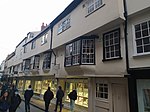33–35 High Petergate

33–35 High Petergate is a Mediaeval building in the city centre of York, in England. The oldest part of the building was constructed in the 14th century as part of a terrace facing Stonegate, this part now known as 60 Stonegate. The main part of the building, two houses now numbered 33 and 35 High Petergate, is timber framed and was originally of two jettied storeys, built at an unknown date. Around 1600, a jettied second floor and attic were added, and 60 Stonegate was combined with the High Petergate row. At the corner of the building is a dragon post inscribed ":ANNO:DO:1646".In the early-18th century, an extension was added at the rear of the building, doubling its depth. 33 Petergate was altered in early 19th century, and a small brick-built rear wing was added. Later in the century, shop fronts were inserted at ground level, and these survive. Inside, there are several early doors and the upper part of the staircase in 35 is also early, while the lower part is 18th century. The staircase in 33 is early 19th century.The building was grade II* listed in 1954. It is currently divided into two shops, with flats above.
Excerpt from the Wikipedia article 33–35 High Petergate (License: CC BY-SA 3.0, Authors, Images).33–35 High Petergate
Stonegate, York Bishophill
Geographical coordinates (GPS) Address Nearby Places Show on map
Geographical coordinates (GPS)
| Latitude | Longitude |
|---|---|
| N 53.96143 ° | E -1.08262 ° |
Address
Bradleys
Stonegate
YO1 8ZW York, Bishophill
England, United Kingdom
Open on Google Maps











